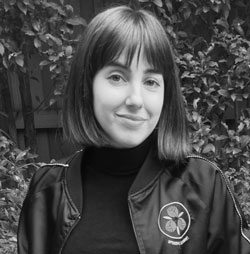As artificial intelligence (AI) becomes more sophisticated and regulations struggle to keep up, global concern has arisen about its place in the creative industries. People have begun questioning the ethics of AI art and what it means for those working or pursuing a creative career, particularly digital painting. How will AI impact artists such as digital illustrators and concept artists? The ever-evolving technological landscape shows no signs of slowing down, so, as an artist, it's vital to build the skills that will allow you to adapt to whatever comes next.
We explore what AI art is, the types of AI art available, and hear from concept artist and CGS Dept. Head of Digital Painting, Brandon Reimchen (EA, Activision, Capcom, Disney Interactive) on how artists should and shouldn't use AI for their art.
What is AI Art & How Will It Impact Artists?
Understanding what AI art is—its strengths and limitations—and how best to use it is the key to making it work for you rather than against you.

Digital painting by Concept Art and Illustration Foundations graduate, Elizabeth Hoffmeister.
What is Artificial Intelligence (AI) art?
AI art is any form of digital artwork, such as images, text, audio, or video, created with the assistance of artificial intelligence. (Artificial Intelligence is the simulation of human cognition by machines, particularly computers.)
Humans may also be involved in the AI art process by adding prompts or data (i.e., imagery including paintings, photos, print ads, cartoons, etc.), but the final creation is left to AI.
This method has been around for a while, however, it has only achieved widespread notoriety in the last few years.
What is Machine Learning?
Machine learning is a type of artificial intelligence that enables computers to learn through "experience" (typically, scraping the internet or another large dataset), without being explicitly programmed by a human.
Machine learning relies on algorithms that can identify complex patterns in data and use those patterns to make decisions and predictions. It helps computers to analyze large amounts of data quickly and accurately, making it a powerful tool in many fields, including healthcare, finance, government, retail, and more.
The algorithms (a list of rules laid out in code) used to generate AI artwork can range from simple ones that use randomness or chaos theory-based approaches to more complex methods such as neural networks, deep learning, and natural language processing.
Software and tools to create AI art
Below are some of the common AI art-generating tools used to create digital imagery.
Midjourney
Using a combination of machine learning and generative art techniques, Midjourney AI Digital Art System produces content based on user input, including an initial uploaded image as their starting point. It's known for creating more artistic, painterly art.
To create art on Midjourney, users must first enter any instructions they want via a Discord channel. This includes different art style parameters such as medium, color palette, stroke patterns, and brush size.

Jason Allen’s A.I.-generated work using Midjourney called Théâtre D’opéra Spatial. He won first place in the digital category at the Colorado State Fair in 2022, which sparked controversy.
DALL·E
Deep Artificial Language Learning Engine, or DALL-E (stylized as DALL·E), produces creative art from text descriptions, interpreting natural language such as written descriptions and commands. It's known for creating more photorealistic art.
DALL-E is similar to Midjourney; some main differences include that DALL-E is run from a full website and can edit existing images by adding or removing elements, whereas Midjourney cannot.

AI art created by traditional painter and sculptor Chloe Wise, using the prompts "advertisement for women’s handcuffs" and "advertisement for motorcycle helmet made from focaccia."
Google Deep Dream
Google DeepDream is an artificial neural network created by Google in 2015. It works by taking in a picture or video and applying algorithmic filters to make the image appear more surreal.
The idea behind DeepDream is to enable computers to "dream" out pictures and videos in the same way humans do, based on what they have seen before.

A Google Deep Dream generated version of artwork by Canadian artist Robert Gonsalves.
DeepArt.io
Another neural-network-based AI technology, DeepArt.io works by taking a user-uploaded image as input and transforming it into a stylized version of the original. It offers a variety of styles that can be applied to an original uploaded image, ranging from classic artworks to modern art.
DeepArt.io also provides users with options for customizing their artwork, such as brightness and contrast adjustments, color corrections, cropping, and more.
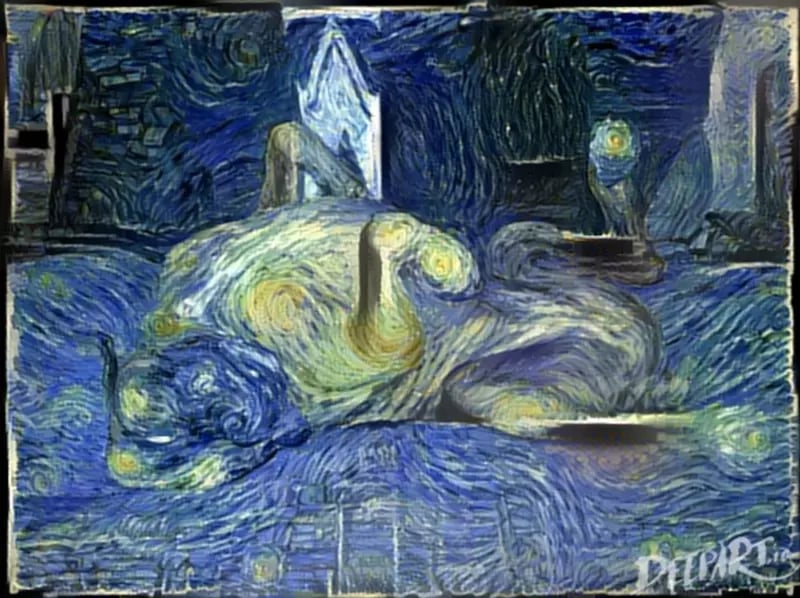
Pug painting in the style of Vincent Van Gogh's The Starry Night, generated by Deepart.io.
What are other types of digital art?
Most digital art forms that are not AI-based require a high level of technical and creative skills to master. There are many types of digital art, including:
- Digital Painting: Combines traditional art skills and techniques with modern technology. An artist will generally operate their stylus like a brush or pencil to execute illustration and painting techniques within a software program, like Adobe Photoshop, using a computer screen or tablet as their digital canvas.
Digital painting and its many subcategories (for example, digital illustration, concept art, and splash art) are generally faster and more cost effective than traditional painting, making it an ideal medium for the fast-paced entertainment industry. - CGI Art: Also known as visual effects, or VFX, this type of art is created in virtual 3D space through digital software and hardware rather than in the physical world using practical tools like clay, paint, fabric, etc.
This art form still requires many of the skills of a traditional artist, along with a more technical aptitude. CGI art is commonly used in film, TV, and games but is also used for advertising, visualization, and VR (virtual reality). - 3D Modeling: is a subcategory of CGI art. 3D modelers digitally build, sculpt, and detail 3D characters, props, vehicles, and sets using computer software and a tablet. Not only must a model meet all artistic requirements, but it must also be highly functional and able to work with other departments and their tools.
3D models can be rigged, then animated by a 3D animator, placed as a stationary object in a scene by a layout artist, simulated or destroyed by an FX artist, and used for shadows or holdouts by lighting artists.

- Algorithmic Art: a form of digital artwork created through algorithmic processes. It combines the power of programming and computer science with traditional artistic practices to create interactive, generative pieces often designed to explore aesthetic possibilities and engage in creative play.
Examples include fractal patterns generated by recursive algorithms, generative music compositions created using artificial intelligence systems, and computer-generated 3D shapes based on mathematical equations. - Generative Adversarial Network (GAN): GANs are a type of deep learning algorithm that use two neural networks, a generator and a discriminator, to learn the features of a given dataset. The generator is trained on the data to create realistic images based on those features, while the discriminator is used to identify “real” images from the generated ones.
The famous AI-generated painting created by the creative studio Obvious, titled Edmond de Belamy, used GAN AI.
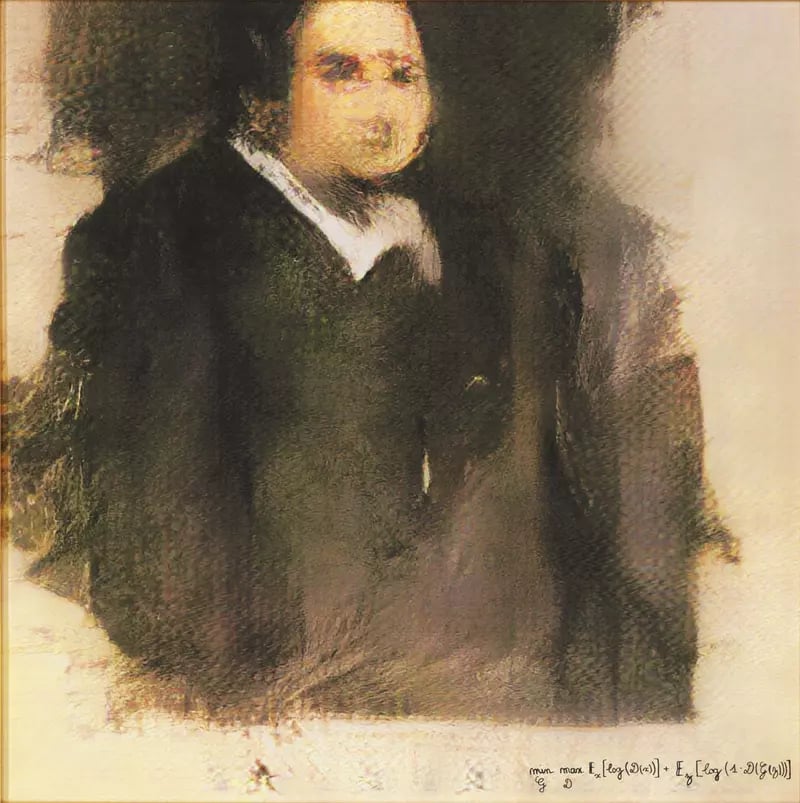
Referencing 15,000 portraits from various periods, Obvious's AI-generated digital painting Edmond de Belamy made the news in 2018 when it sold for an incredible USD 432,500.
How does AI art impact artists?
Within the creative industries (and beyond), the ethical questions surrounding artificial intelligence are stacking up alongside technology’s rapid and unchecked incline, and creatives have begun asking how AI will impact artists. Brandon Reimchen, a concept artist with two decades of experience, helped us answer some of these questions.
How can AI art assist the creative process?
Concept artist and CG Spectrum Dept. Head of Digital Painting, Brandon Reimchen, thinks that AI art in its current form shouldn’t be seen as a hindrance to artists but as a tool they can use to help speed up creative workflows and generate new ideas.
Brandon says AI art can be useful. It can assist in producing a base for first-pass concepts for a client (to help get the ball rolling) or provide multiple options (similar to a mood board) when a brief is still undefined. He has tried AI art in the past and has benefited from this technique in earlier stages of his workflow, but he points out that getting the right image from AI using input and prompts can still be time-consuming. A creative eye and solid digital painting skills will help speed up the process.
"I could waste days on end trying to get the perfect piece of AI art or I could get something rough out and then start painting into it, using my experience and grasp of art fundamentals to make it an actual piece that I can use and which can potentially speed up my workflow.”
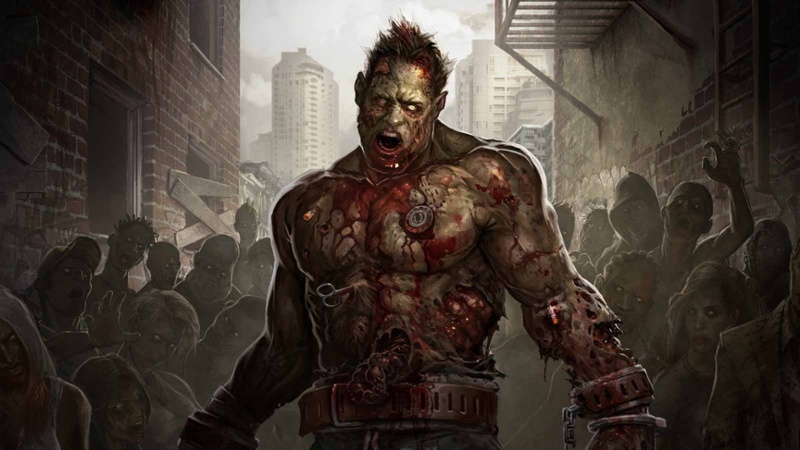
Digital illustration by Brandon Reimchen.
Regardless of its benefits, understanding the fundamentals of art and learning essential technical and creative skills is still a prerequisite to becoming a successful digital painter.
Brandon advises his students not to rely on AI art if they want to improve as artists. The only way to hone your skills is through practice, which not only helps you speed up your workflows but also allows you to grow and develop by learning from your mistakes. Simply using AI art will not achieve this vital step in your growth as an artist.
Practical and ethical issues of AI art
If you want to become a serious artist and make money from your art, certain AI programs can actually act as a barrier against commercial sales due to copyright issues, Brandon warns.
"AI models represent a moral issue as they scrape images without licensing. Using AI for internal mood boards and inspiration is fine, but it should not be used for the final product.”
There are not only moral limitations but also practical limitations to how AI art currently operates. One example is that AI art doesn’t (currently) have the ability to produce the same image from a different perspective/angle, which is a common client request, particularly in concept art. AI also struggles to understand many of the nuances of human communication: body language, intonation, contextuality, etc.
“Client briefs and feedback require a certain level of artistic interpretation. If a client cannot express what they want properly, it can be a considerable obstacle for an artist to accurately capture their vision. I find when working with a client, once you get to know them, you develop sort of a shorthand, and you know what they mean when they say specific words or use certain inflections. Those same words mean something else to another client, so it’s about relationship-building and also knowing your craft.”
Should artists be worried about AI art?
Brandon is not concerned about AI art in its current state because, although it is derivative of human art, it is missing its own humanness. Many artists, including writers and musicians, have taken a similar stance on AI art. Singer/Songwriter Nick Cave recently wrote about ChatGPT in his weekly newsletter, The Red Hand Files (issue 218):
"[A]lgorithms don’t feel. Data doesn’t suffer. ChatGPT has no inner being, it has been nowhere, it has endured nothing, it has not had the audacity to reach beyond its limitations, and hence it doesn’t have the capacity for a shared transcendent experience, as it has no limitations from which to transcend.”
One way to demonstrate your humanness is by recording your creative process to showcase within your portfolio. For example, if you’re using Procreate to create your art, you can simply export the process video to add to your portfolio or on your socials.
"When constructing your portfolios, don't just focus on the final piece. Show how you got there. Include sketches and iterations which walk people through that human process. Recruiters/studios will get a better idea of what it would be like to work with you.”
Should artists use AI?
Whether you embrace AI art in your creative process or not, Brandon advises artists not to shun new technology, like AI art, because it may result in getting (technologically) left behind.
“I think AI art highlights, even more, the importance of getting good at being technically sound as an artist. That way, if AI art sticks around, you will be able to use it if you need to. If art devolves to become about simply pressing buttons, you'll be the better “button presser” than some random person who has no art fundamentals.”
How can artists protect themselves from AI art?
We cannot predict the future of AI, what increasing technological advancements will bring, or what that means for artists. So, how do creatives ensure they remain employable in the face of new, faster, cheaper options like AI art?
"I think the only thing you can do to protect yourself is become really good at being an artist.”
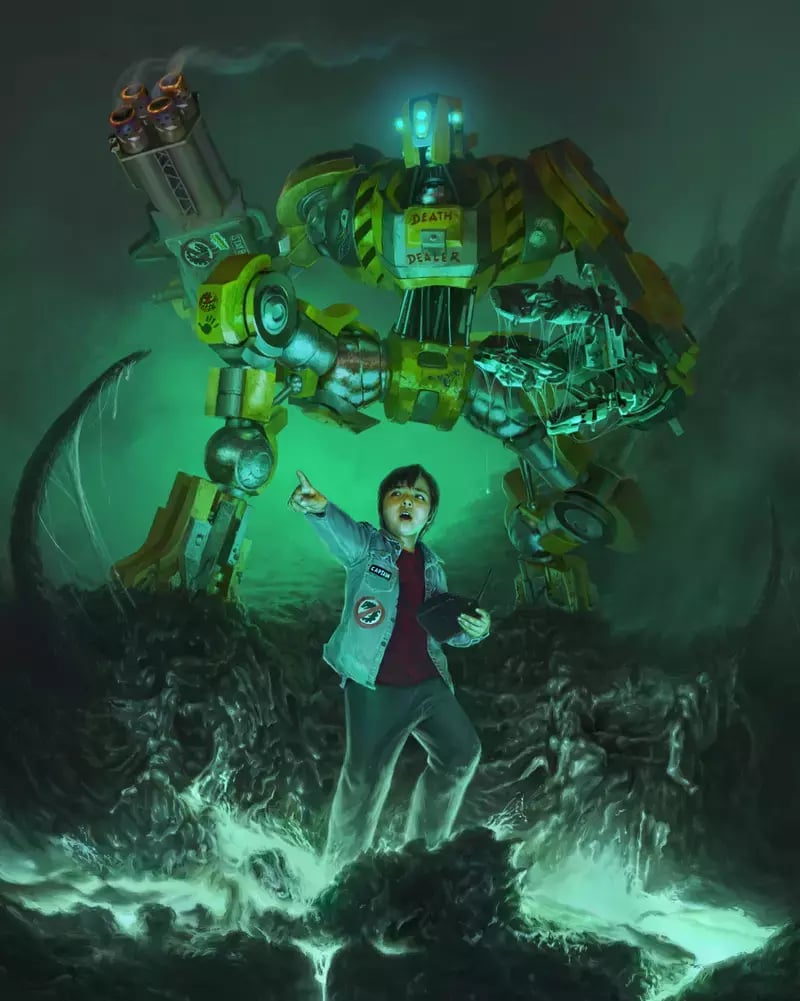
Digital illustration by Digital Illustrator Specialization grad Luis Inzunza, who, since graduating, landed a job at Monumental!
How to start a career in digital art (and become a good artist)
Led by experienced artists like Brandon, our concept art and digital illustration courses will teach you the essential creative, technical, and interpersonal skills that studios are hiring for, no matter what role you wish to pursue within digital painting.
Staying abreast of industry standards and trends, our curriculums, taught one-on-one or in small classes (max. 4 students), are designed to prepare you for the dynamic film, game, and publishing industries and to be able to face any challenges head-on.
Related Links
